Six North Faces of the Alps: Grandes Jorasses, Walker Spur
.
The next in our North Faces of the Alps six part series from IFMGA Mountain Guide and Glenmore Lodge instructor Stuart McAleese.
The North Face of the Grandes Jorasses
Walker Spur
Time taken: Approx. 10hrs on route and 6/7 hrs descent to Val Ferret. Total 17hrs
Climbing partner: John McCune (total hero, top big alpine mountaineer and climber, IFMGA Mountain Guide)
A very big thank you to IFMGA Mountain Guide Kenny Grant and IFMGA Mountain Guide Tim Neill for providing us with some fabulous photos.
.
.
In some ways this felt like the biggest and hardest of all the six Alpine North Faces. Long approach to a big difficult climb at altitude. Ever since my first season climbing in the Alps, I have always wanted to climb the Walker Spur on the Grandes Jorasses. Most of the time things just didn’t come together for it to be possible. There are many aspects that need to work for this route: time, acclimatisation, fitness, good weather and the right conditions on the route itself. It’s the big one! It is respected for its size, scale and difficulty.
In previous years I’ve been lucky enough to climb other routes on the Grandes Jorasses. The Shroud and the Colton-MacIntrye with Kenny Grant, and a high attempt on the Desmaison-Gousseault route with Rich Cross and Dave Hollinger, but never managed to get everything aligned to climb the Walker Spur.
When the route was first climb by Riccardo Cassin and his team back in 1938 it was a big move in Alpine climbing standards and still today it is regarded as a classic hard alpine climb and respected throughout the world alpine climbing community.
.
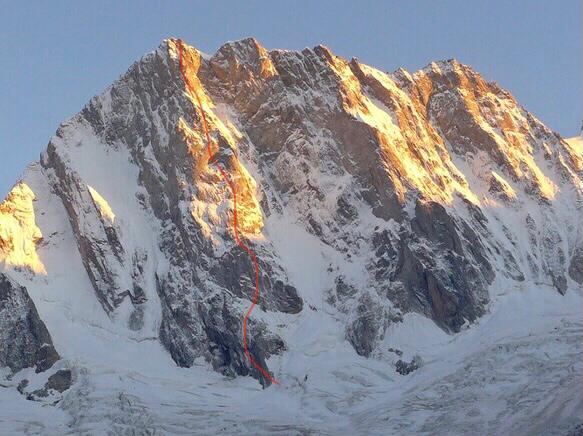
Photo: IFMGA Mountain Guide Kenny Grant
.
.
Trip Report
It was early August 2017 and the weather was nice and sunny in Chamonix, I had a few days off work and the Walker Spur was looking good and clear of any snow. It was August, but the temperature was ideal, not too hot, so I didn’t have any big concerns for rock fall around the route.
Conditions update on the mountain are easier to obtain nowadays and the base hut near the Grandes Jorasses looks straight onto the North Face and honest accurate reports are regularly posted from the Guardian of the Leschaux hut. The Guardians of these often remote and little mountain huts are often experts of the area/IFMGA Mountain Guides and know the climbing conditions well. Photos of the North Face posted online were looking good and there were reports of teams climbing the route as well.
I called a friend, IFMGA Mountain Guide John McCune, to see if he was free for a climbing adventure…he replied with a yes. I had climbed alpine routes with John before. He is a world class climber and awesome alpine rope gun. We had both seen the weather forecast and the condition reports on the mountain, so we continued our research and got ready. There was one small problem… we both only had two days free, so this meant only 1 day to complete the climb. This definitely helped us focus, packing light and planning on climbing light for a single day push.
Although a single day on the route itself is normal if the conditions allow it, most ascents have a bivouac at some point, maybe the summit or high on the route. This is mainly due to the length and difficulty of the climb. The climb is faster when free of ice/snow on the actual route and warm conditions allow you to climb in rock climbing shoes.
Whilst it is a committing approach, with our combined alpine experience we felt confident and planned carefully for a single day push.
This Walker Spur attempt was going to feel different to others as it was in the height of summer, unlike my other experiences which had been in the late Autumn / early Winter.
The evening before we phoned the Guardian at the Leschaux hut and booked an evening meal and space in the hut for the night before the climb. The Leschaux hut is a very special place, a remote and little mountain hut surrounded by big mountains looking straight up to the North Face.
There are so many unknowns to climbing the big North Face routes. Even though we had done all our homework and planned well, we still did not want to take things for granted so we agreed to ‘go and have a look’ with the possibility of always turning around if things didn’t feel right. Aiming to leave Chamonix under the radar, thus avoiding the weight of expectation we had asked a friend for a pick up on the other side in Italy and agreed to call, once on the descent.
We jumped on the Montenvers railway and slowly made our way out of the valley. It takes about 3 hours to walk there, up the long Mer de Glace glacier and later the Leschaux Glacier under the Grandes Jorasses itself.
My previous attempts on the Desmaison/Gousseault climb involved a walk from the valley as the train has been closed. So sitting eating a sandwich on the train and looking down on Chamonix, I was very grateful and thought back to all those long hard walks with heavy rucksacks.
Getting off the train at the Montenvers Railway station with massive climbing rucksacks and ropes was the first challenge and it was really nice to see good friends Tim Neill and John Orr , who had been working in the mountains that day and were on their way down to Chamonix. A quick chat in the train queue bustle and a good luck wave made us both smile.
Soon we were on the Mer De Glace walking on hard glacier ice with piles of moraine everywhere and as the day went on everything got quieter and the mountain feel kicked in.
After an hour or so we paused for a break, and in the distance, we could hear the ‘faint final train for Chamonix’ announcement.
Wanting to get to the Leschaux hut in good time, to rest, recover and watch the mountain in good light before dark, we stumbled on and picked our way through the lateral moraine of the Mer De Glace to join the Leschaux Glacier.
.
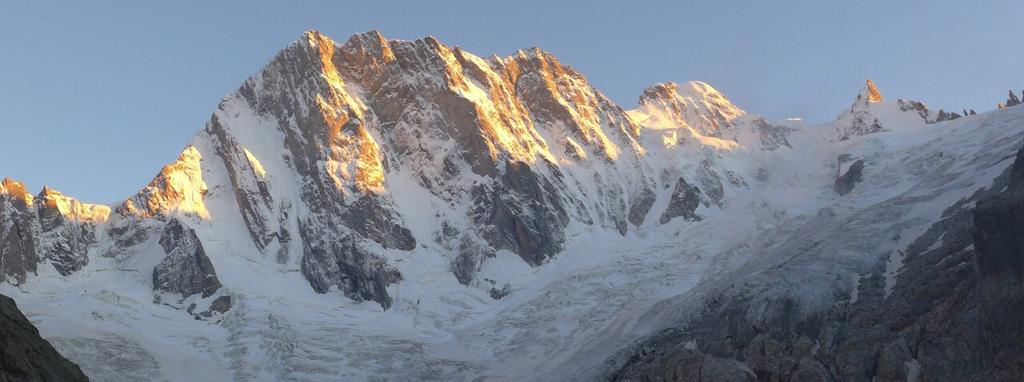
North Face of the Grandes Jorasses, Photo: Kenny Grant IFMGA Mountain Guide
Carrying on, casting a look up at the Envers hut, we received a cheery wave from the Guardian who has previously given us good information about the Walker Spur. A very special place, the Envers hut. The mountains there have some of the best big rock climbing ever. It has its very own guidebook full of big mountain rock climbs. As the hut has such a long approach, most climbers stay there at least 2 nights to maximise the climbing and enjoy the superb alpine location.
.
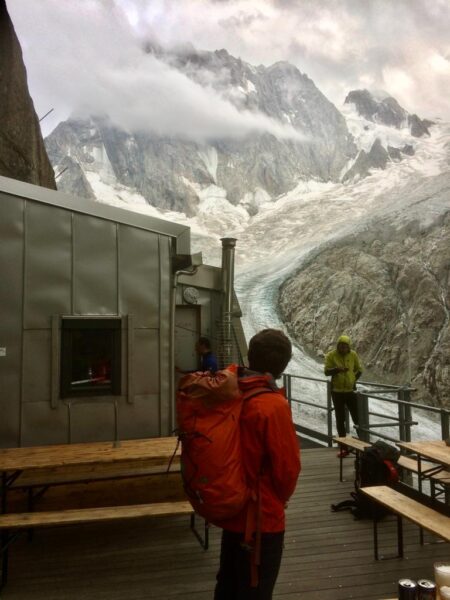
Arriving at the Leschaux Hut
Through the moraine we continue and on to the Leschaux glacier. We could just make out the hut. We had been walking for a couple of hours now and the Grandes Jorasses was starting to look big. I never really do any running/cardio training and always regret that in times like these. Trying my best to keep up I was looking forward to a nice cold drink at the hut and a good rest. Little cairns in the moraine marked the way and soon we were under the hut, just off the glacier. There is a set of fixed ladders and steps to access the hut as it sit about 80m above the glacier.
We stopped here to think about logistics. We didn’t need to take all our gear to the hut so we made a little gear stash somewhere near the base of the ladders. Visualising being there in the dark and looking at how far we would have to walk to the Grandes Jorasses, we estimated it would take around 3 hours to reach the base of the Walker Spur.
Climbing up the ladders passing really cool crystals in the granite we received a warm welcome at the hut and we sat on a table outside on a small wooden balcony. The hut cat was interested and came to check in on the new visitors.
A brief check in and we were given a time for evening meal and asked what time we would like breakfast? More for protocol as breakfast would be left out for us. Relaxing on the balcony we used the hut binoculars to investigate the route through the crevasses and a quick look at the route itself. The hut guardian was really helpful and explained current conditions and observations. We spoke about other climbing teams experiences that summer and when asked about our logistics and thoughts too, we explained we were aiming to climb the route without bivouac and to reach Italy the same day. The Guardian was supportive given such good conditions and left us to prepare dinner while the cat kept us company.
.
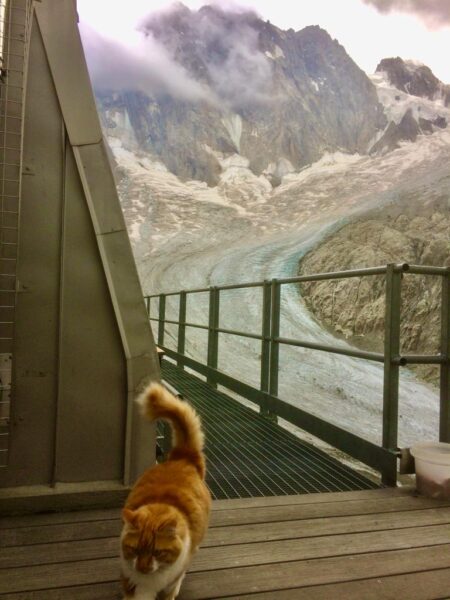
.
The Leschuax hut is very small but inside there are lots of home comforts, full bookshelves and is somewhere I’d love to spend more time, however I’m normally on some alpine mission and getting up in the middle of the night to set off climbing.
We were the only team heading for the walker spur from the hut, but other climbers were keen to share their thoughts and experiences over dinner. We all joined in swapping climbing experiences. Soon a folder full of various topos and routes descriptions for the Grandes Jorasses North Face was put on the table. Every topo and description you could think of was in that folder in various forms, some hand drawn photocopies and other detailed photos from guidebooks.
Trying to process the different topo photos and listen to advice at the same time got a little confusing. Our route finding and being efficient was going to be important as the route is big at 1200m of climbing (approx. 30 pitches), so it could be easy to get a little lost or climb ‘off route’, these things happen, so any inside knowledge/tips and advice was welcome. It is easy to question and doubt aspects the night before a big climb, so it was really nice when we both decided on the descriptions/topos we will use and could relax for the rest of the evening.
We aimed to get to the base of the climb around sunrise, if not a little before. It is normal to climb early sections in the dark to get ahead of time, however sometimes I’ve found it counter productive being too early and have had route finding issues in the dark on complex climbs. So, we set our alarms for 2am, aiming to have breakfast and leave the hut at 2:30am…
.
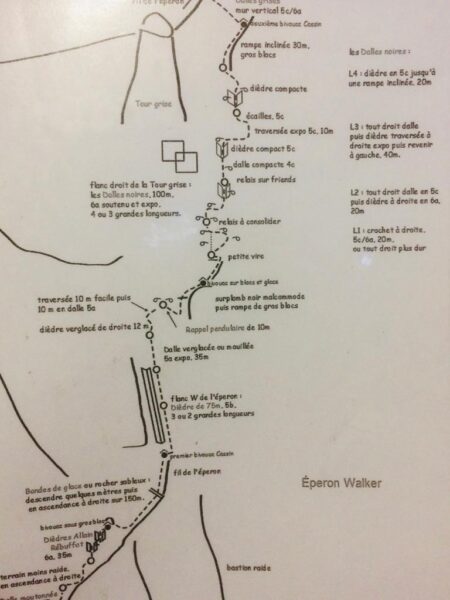
Lower section of the route
It was a short night’s sleep and soon we were down-climbing the ladders to the glacier in the dark. There’s always a strange feeling setting off in the middle of the night, all quiet, dark and feeling like the rest of the world is sleeping….what helps me get through those thoughts is that it will be sunrise soon and that’s always amazing.
On the glacier we found our gear stash, put our gear and crampons on as quick as possible and soon we were walking up towards the Grandes Jorasses. The glacier was stripped of any snow at this stage and was hard ice, which made for easy walking but soon felt tough on the legs with heavy bags, again wishing I’d done some running/cardio training, oh well… At least we were both acclimatised. This is important as the summit is around 4200m and we were going to be working hard.
Conditions changed under foot with more snow around us and as far as we could see, so we decided to rope up for glacial travel, tied on to the rope some 15-20m apart.
A few crevasses started to appear. Initially you would only see an edge, but on closer inspection some were abyss size crevasses. Totally expecting these big crevasses, we slowly walked around them trying to still be efficient. Close to the North Face now and the glacier was looking good as far as we could see with our head torches, then suddenly bang! Like a shot gun crack through the ground, both of us stopped and I took a breath/froze for a moment.
Looking around our feet initially fearing that we had stood on a massive crevasse, but no, there was nothing there just hard frozen snow?
‘woah what was that’?
We paused and assumed it was the glacier expanded at depth releasing/moving. Both of us had heard things like that before but it always gives you a little shock.
Trying to forget about the bang, we kept moving up slowly and after a while we could clearly see the base of the route and were pleased there was no big crevasse problem, which can be normal here.
Still in the dark we find a secure place at the base of the route and make the transition from walking/mountaineering to climbing. It was quite warm so we both agreed rock climbing shoes were going to be better. John is an extremely strong climber and alpinist, so we agreed for John to set off in lead first, I didn’t want to slow us down right from the start. The rock was icy in places and it was still dark, so climbing with head torches on, we started the climb.
We knew the first 100m or so was a ramp like feature and from the topo we were looking for a set of cracks after this.
Soon John was in turbo alpine mode and the rope came tight, so I put my rucksack on and started climbing. I knew we were moving together so climbed with caution but at the same time tried to keep up with the pace!
Rock climbing with a heavy rucksack is hard to get used to. It never feels easy and it is times like this that you appreciate packing as light as possible. It was getting light and I remember after around 100m of climbing passing a small cave, I looked inside and saw a little hammer and huge granite crystals. They say that crystal hunters claim their find by leaving their hammer in place. I’m not exactly sure but these were some pretty hardcore extreme crystal hunters at 100m up the Walker spur!
Next we had a choice of corners to climb. Wanting to get the right one we had a quick look at our topo, which didn’t really help so we went for the most obvious and the one that looked like it was climbed the most. It was tricky to tell exactly, as there were clues in both corners; pegs, old equipment and sometimes bits of rope indicating belays. We chose one and John the alpine run gun made it look easy, again the rope came tight and I started climbing. This was the Rebuffat corner and it was at this point that we both felt the climbing really kicked in, especially carrying heavy rucksacks, feeling like solid granite VS/HVS climbing. It might be that I’m getting older, but granite walls and slabs can feel hard!
The climbing then eased off, but never really to the extent we were hoping. We made a change and I took over leading for a little while. The block leading does work well on these big routes and allows focused time leading and a decent time recovering on the second.
The climbing was easier so with plenty of runners in we decided to move together. This is still serious, but we had to maximise these opportunities, especially if we wanted to make the summit and descend to Italy that same day.
Our next route-finding landmark that we had to find was a big long corner. This would ensure we were on route and making good progress.
Rope drag was bad through this easy ground, avoiding loose rock and climbing round corners. We paused at a belay for a quick regroup and topo check. This was a good time for any quick food and a little drink. I was mainly carrying cheese, salami, energy gels and the odd chocolate/cereal bar. I think we were carrying 1 litre of water each and just in case, we had a stove too.
The topo was good and indicated we needed to search right a little. This looked very unlikely, but we didn’t have much choice. After some more climbing we found it! Also known as the 75m diedre. This meant we were on route and doing ok time wise.
.
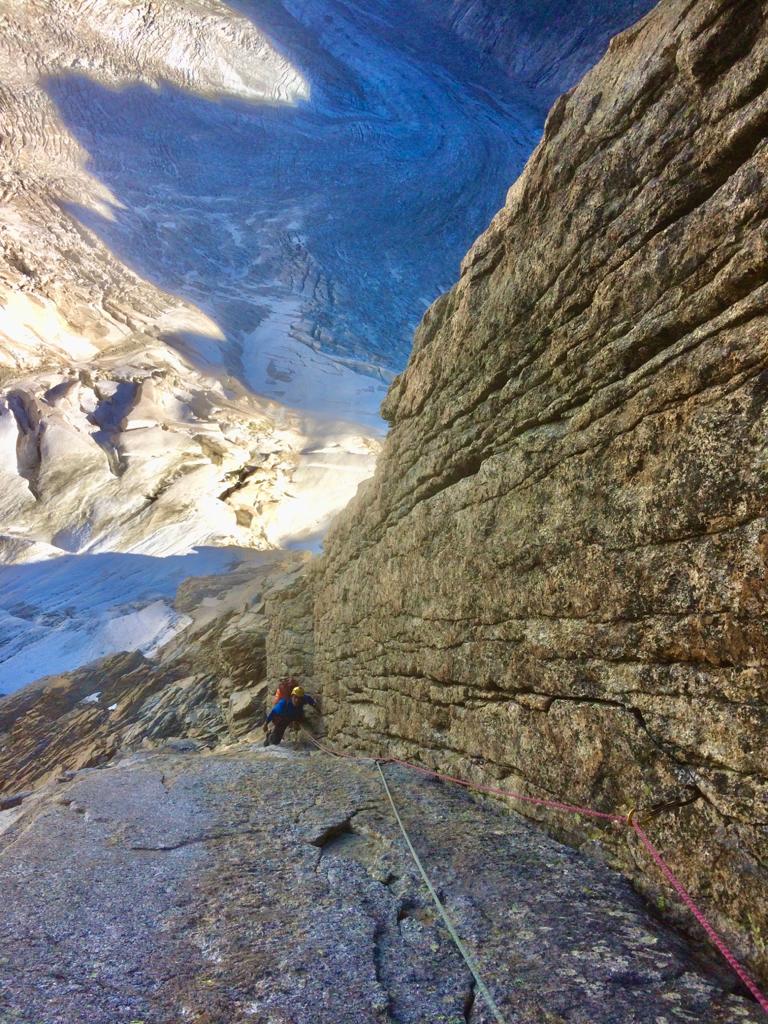
75m diedre
At every chance we would take off our rucksacks and clip them to the belay for a little rest between climbing. I could see there was a lot of gear in the corner so decided to push on leading, I’m sure John could’ve climbed it faster, but I wanted to do my bit while I still could. After a few pitches of solid quality rock climbing we climbed out of the big corner.
We were happy the route was so clear and dry of snow, it meant we didn’t have to change to crampons to cross a snow/ice slope which is how the route can be. This would have slowed us down so we were relieved to find it so dry. In fact we were lucky and climbed in our rock boots for the whole route.
I needed a break and John took the rack, he set off climbing, this time up open big rock slabs with the odd piton along the way. All the time both of us were monitoring our progress by looking across the face into the Colton Mac route. Even though we were doing well, the amount of terrain above us looked massive!
.
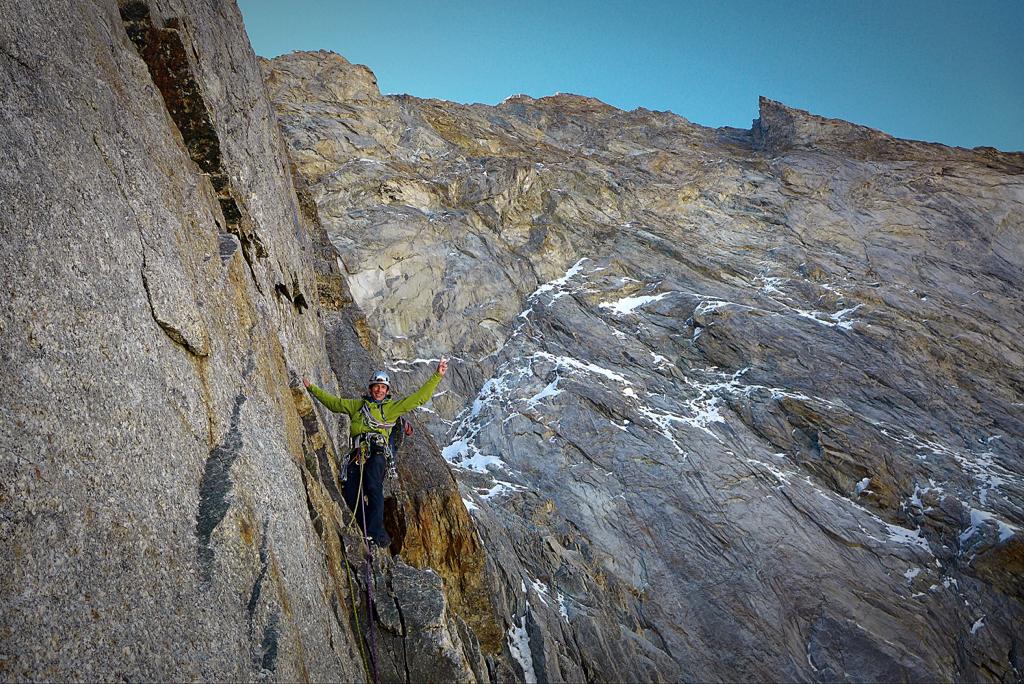
Climbing on the Walker Spur. Photo IFMGA Mountain Guide Tim Neill
Another key section was a small abseil to access another ramp system. We found this but it wasn’t quite what we expected. We were both expecting a short abseil to an obvious ramp system, instead what we found was a quite committing abseil to a small belay point hanging above a huge wall dropping into the Colton/Mac snowfield. It felt a little odd to be abseiling given we still had so much to climb, but with little time to hang around we went for it. Often, we would normally avoid these transitions as they take up too much time, but this felt important. We were both surprised at the quality of the abseil and belay points at this stage. Looking a little historic we placed a couple of back-up pieces of our own and held our breath abseiling into the abyss. We might have been off route, but everything worked just fine.
Aware that we had spent some time on that last transition, we kept climbing with little rest. Lots of sustained rock climbing followed up amazing walls and granite slabs of the Tour Grise. We were unsure exactly of our route and position so we kept going up!
High on the route now we came across a bivouac ledge overlooking the Colton/Mac and the next feature we were looking for was the Red Chimney. We had a little break on the tiny bivouac ledge, only big enough to stand on really, both of us were quite pleased we weren’t spending the night here. We sorted the ropes and checked the topo. The summit ridge was in sight but we both knew we still had lots of hard climbing to go.
High on the mountain now we both needed another layer, lucky to still be climbing in rock boots, although there was more ice around now on some of the climbing.
Climbing higher we were now at the base of the Red Chimney, we had a choice of two lines but both looked a little loose. It was cold with ice around many of the blocks, we just had to climb with caution and not really pull on anything, bit like Jenga!
.
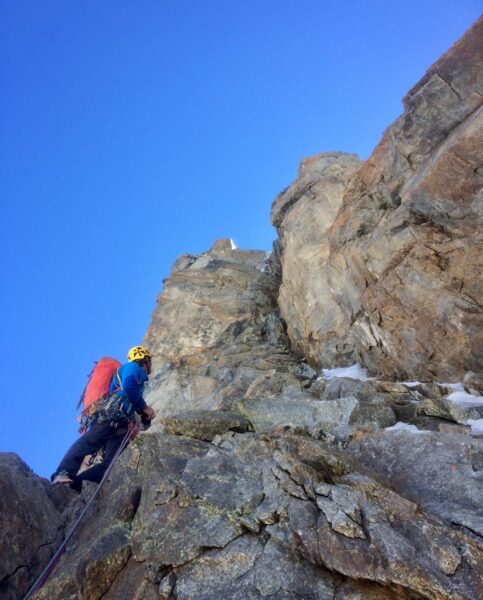
The red chimney
Over the red chimney and we climbed a huge flake rightwards. This was covered in ice and was cold and pretty strenuous, gripping onto the ice covered edge while trying to smear on black ice footholds. Rightwards further and we got some shelter from the cold wind in a little cave and belay.
Above us you could see a few pitons and bits of fixed cord, normally these would be easy to clip and use but this time they were all covered in water ice. A tough little pitch which John did an amazing job on, bridging the overhanging cave covered in icicles, up and over to easier ground. There’s always at least one awkward and terrifying pitch, wet and covered in ice on all these big North Face climbs. Easy to forget about afterwards but at the time a mildly horrific experience, especially at this stage in the climb.
.
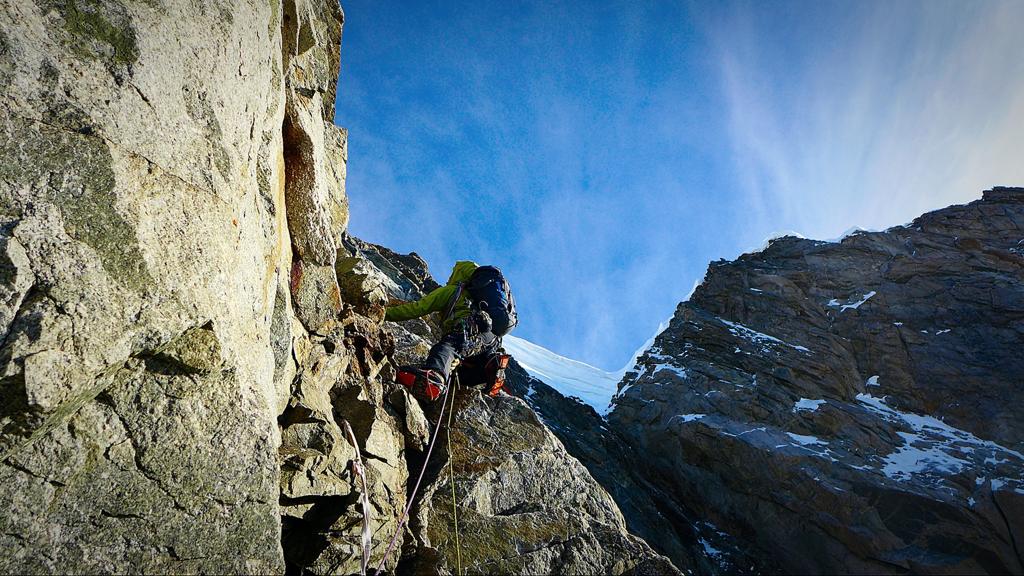
Near the summit. Photo IFMGA Mountain Guide Tim Neill
High on the mountain now, we both felt cold and were tired. Looking forward to topping out, we could see the summit and climbed steep but easy terrain for a few pitches to arrive beneath the summit cornice. Looking at the time it was nearly 15:00pm, we’d been climbing solid for the last 10 hrs. We changed from our rock boots to mountaineering boots, crampons and got our ice axe out too, both commenting on how lucky we were, able to climb wearing rock boots the whole way up the route.
We pulled through the snowy cornice 15 minutes later and we were on the summit. A quick high five and we were happy.
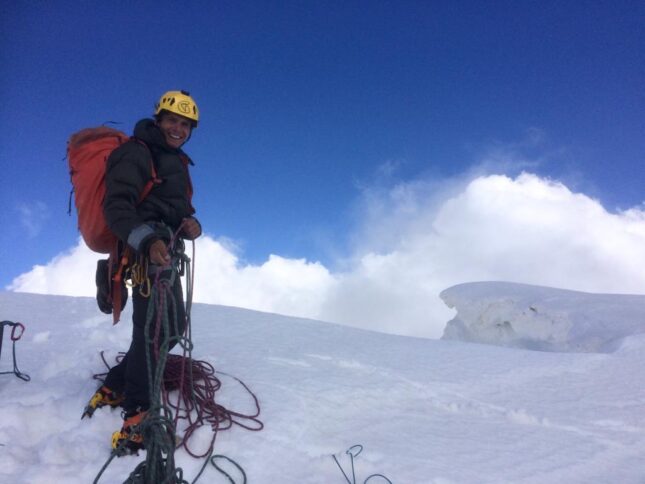
John on the summit with afternoon clouds building
Sitting in the snow for a while having a little rest, reflecting on our efforts we felt lucky to have had the entire route to ourselves and done it in such good time. All thanks to John’s superb climbing, I tried to keep up and hoped I didn’t slow us down too much. We both commented on the quality of the route and how hard and sustained the climbing was, reflecting on our efforts, feeling lucky to have such warm good weather for climbing. A little ping came through and it was the hut Guardian, we sent a message to say we were on the top and we got a nice reply ‘I can see you, well done’. Looking through binoculars the Guardian can monitor climbers progress from the Leschaux hut.
We both smiled and soon our thoughts turned to the descent.
.
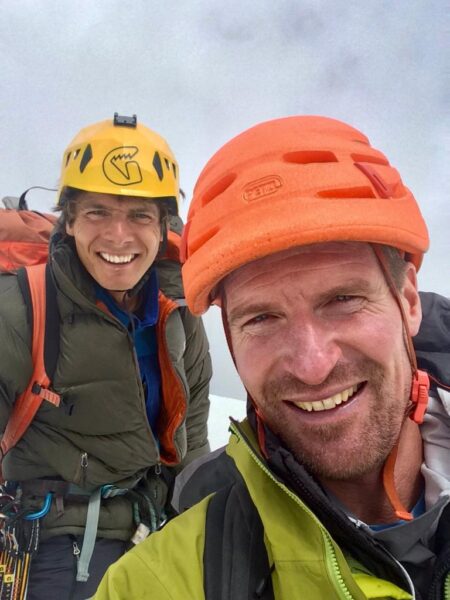
Summit selfie
With clouds building around us, we were hoping the weather would hold for our long descent to Italy. After a little food and now down to our last bit of water we set off down the normal route of the Grandes Jorasses. Both of us had descended this way before, so we knew the challenge ahead and hoped the route was in ok condition given that it was now late in the afternoon.
There was a faint track in the snow which helped, afternoon clouds were building around us, so visibility was poor. We down climbed the snowy ridge, and this leads you on to the glacier. This had some huge crevasses that needed negotiating, with one including a jump over because the snow bridge had collapsed. You should try not to look down mid jump, but you can’t help it, and mid jump somehow out of the corner of your eye you see the void!
Safely making good progress we descended the next ridge and onto the final glacier, the weather was holding, and we paused at the bottom of the glacier to take the ropes and harnesses off. Some 13 hours on the go and I was starting to feel it. I’d pulled a muscle in my hand and my legs were wiped. John was going strong and I was familiar with this kind of fatigue, I was tempted to rest a little while, but it was better to carry on moving. We had a message from a friend that he would drive through to Italy to pick us up at the road in Val Ferret. This was amazing and meant we would be in Chamonix that evening.
We arrived at the Boccalatte hut around 19:30pm and had a little break on its balcony overlooking the valley and an amazing sunset. The Guardian came out to chat and offered us some food. We had a beer and took our boots off for a while. We talked about the Walker Spur and it felt amazing to be safely down near the valley after such a challenging day. The beer felt good and I think this helped with the long descent to the valley.
.
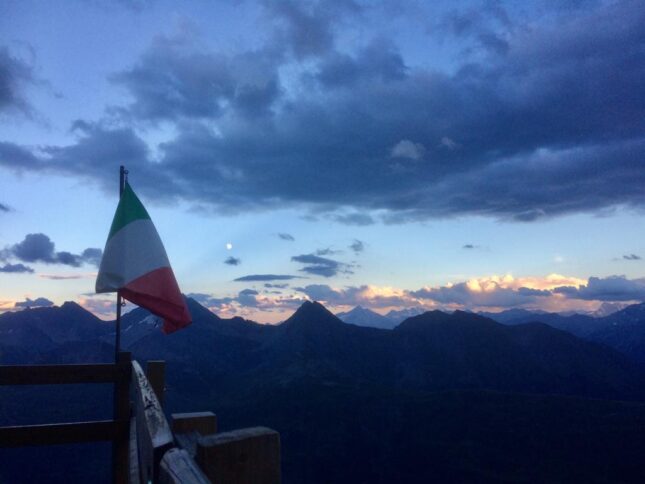
Sunset on the descent at the Boccalatte hut
A few hours later we were in the valley and our friend was there to pick us up. Will is a good friend and it was amazing that he had driven through to pick us up. We have worked together a lot, and Will has climbed on the Grandes Jorasses North Face many times before, so I think he knew how tired we would be. Totally exhausted, I could hardly lift my bag into his car, but it felt so good to relax and switch off. Will was happy to see us and during the drive back to Chamonix we listened to music and swapped stories of the Walker Spur.
Also available to read:
Six North Faces of the Alps: The Eiger
Six North Faces of the Alps: Aiguille du Dru
About Stuart McAleese
.
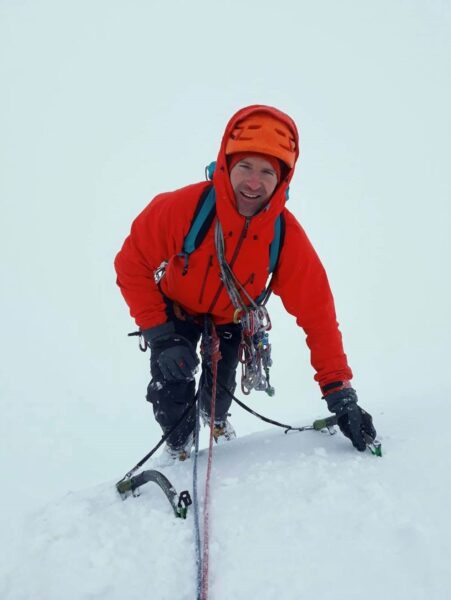
.
Originally from Northern Cumbria I started out hill walking in the Lake District when I was at school. I soon become interested in rock climbing and mountaineering, and was lucky enough to work and climb with Mountain Guides during my first job leaving school. Since then I’ve been working full time in the mountains for around 20 years.
At the same time as working, I enjoy climbing in my free time and have been lucky enough to go on many expeditions around the world, climbing new mountains, first ascents and tough remote summits. Places such as Patagonia, Alaska, Himalaya, Peru, Baffin Island, Yosemite and China. In 2004 I was nominated for the prestigious Piolet d’Or in Grenoble, France, for a 1st ascent of the ‘Supa Dupa Couloir’ in Alaska.
I love my job as a Mountain Guide, teaching and exploring big mountains in all weather all year round. I joined the Glenmore Lodge team in 2019 and head up the Summer Alpine programme.
.